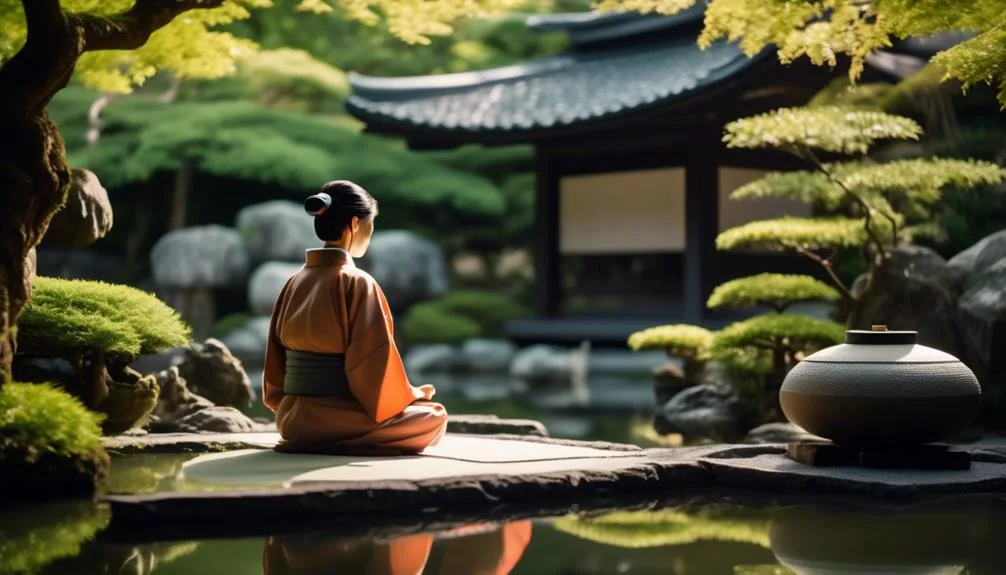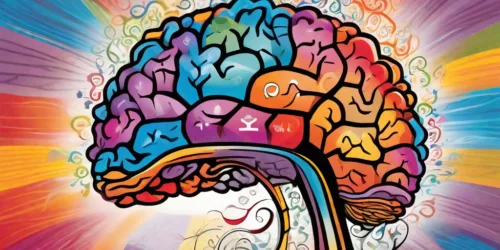Blending Horizons: Discovering Unique Cross-Cultural Meditation Rituals
So, you think meditation is just sitting cross-legged, closing your eyes, and trying to clear your mind?
Well, prepare to have your horizons expanded. In our modern world, where cultures collide and traditions blend, unique cross-cultural meditation rituals have emerged that will challenge your assumptions and open your mind to new possibilities.
From ancient Vedic techniques to indigenous practices from South America, and from Zen meditation in Japan to modern innovations in meditation, there is a rich tapestry of rituals waiting to be explored.
Are you ready to embark on a journey of discovery, where you'll uncover the hidden gems of cross-cultural meditation?
Key Takeaways
- Ancient meditation techniques such as Vedic breathing exercises and mantra meditation offer exploration of consciousness and transformative power.
- Zen meditation in Japan emphasizes simplicity and direct experience, with techniques such as Zazen and Kinhin.
- Shamanic rituals and meditation, including drumming techniques and power animals, promote relaxation, healing, and spiritual journeying.
- Indigenous practices from South America connect individuals to land, ancestors, and inner selves, preserving ancient wisdom and offering connection to nature.
Ancient Vedic Techniques

Have you ever wondered about the ancient Vedic techniques used in cross-cultural meditation rituals? The ancient Vedic traditions from India have gifted the world with a rich tapestry of meditation practices that have stood the test of time.
Two prominent techniques that have gained recognition are Vedic breathing exercises and Vedic mantra meditation. Vedic breathing exercises, also known as pranayama, involve conscious control of the breath to regulate the flow of prana or life force energy within the body. This practice helps in calming the mind, increasing vitality, and fostering a deeper connection with one's inner self.
On the other hand, Vedic mantra meditation involves the repetition of sacred sounds or mantras, which are believed to have a profound impact on the mind, body, and spirit. By focusing the mind on these sounds, one can experience a sense of tranquility, heightened awareness, and spiritual awakening.
These ancient techniques offer individuals the opportunity to explore the depths of their consciousness and unlock the transformative power of meditation.
Zen Meditation in Japan

Now let's explore the unique techniques and cultural significance of Zen meditation in Japan.
When you engage in Zen meditation, you'll notice its emphasis on simplicity and direct experience, allowing you to cultivate mindfulness and a deep sense of presence.
The rich history and influence of Zen in Japanese culture make this meditation practice a fascinating cross-cultural exploration.
Japanese Zen Techniques
Practiced by millions around the world, Japanese Zen Techniques offer a profound and transformative experience through the practice of Zen meditation in Japan. Rooted in the teachings of Buddhism, these techniques aim to cultivate mindfulness, focus, and inner peace.
Japanese Zen practices emphasize the importance of silence, stillness, and breath awareness. One of the most well-known techniques is Zazen, or seated meditation, where practitioners sit in a cross-legged position, maintaining a straight posture and focusing their attention on their breath or a specific object.
Another technique, known as Kinhin, involves walking meditation, where practitioners move slowly and mindfully, synchronizing each step with their breath. These Zen meditation techniques provide a space for self-reflection, self-discovery, and a deeper connection to one's inner being.
Cultural Significance of Zen
As you delve into the cultural significance of Zen meditation in Japan, you'll discover the profound impact it has had on individuals and society as a whole.
Zen meditation is deeply rooted in the cultural context of Japan, shaping the way people think, act, and live their lives. Here are some key aspects that highlight the cultural significance of Zen:
- Zen philosophy: Zen meditation is based on the principles of Zen philosophy, emphasizing mindfulness, self-discovery, and the quest for enlightenment. This philosophy permeates Japanese society, influencing various aspects such as art, literature, and even business practices.
- Integration of Buddhism: Zen meditation is closely associated with Buddhism, and its practice in Japan has helped integrate Buddhist teachings into Japanese culture. This integration has led to the development of unique rituals, temples, and ceremonies that embody the essence of Zen.
- Impact on daily life: Zen meditation has become an integral part of many Japanese people's daily routines. It provides a means to find inner peace, manage stress, and cultivate a sense of harmony and balance in a fast-paced and demanding society.
- Influence on aesthetics: The aesthetics of Zen, known as 'wabi-sabi,' have greatly influenced Japanese art and design. The simplicity, imperfection, and appreciation of nature that are central to Zen philosophy can be seen in traditional Japanese architecture, tea ceremonies, and even the art of flower arranging.
The cultural significance of Zen meditation in Japan can't be overstated. Its influence can be seen in every aspect of Japanese society, enriching the lives of individuals and fostering a deeper understanding of oneself and the world.
Shamanic Rituals and Meditation

Now, let's explore the fascinating world of Shamanic rituals and meditation.
Shamanic drumming techniques can help you enter a deep meditative state, allowing you to connect with the spiritual realm and access ancient wisdom.
Additionally, power animals play a significant role in Shamanic practices, serving as guides and sources of strength during meditation.
Get ready to embark on a transformative journey as we delve into the rich traditions of Shamanic rituals and their connection to meditation.
Shamanic Drumming Techniques
To explore the transformative power of shamanic rituals and meditation, delve into the mesmerizing world of Shamanic Drumming Techniques. This ancient practice has been used by cultures across the globe to induce altered states of consciousness and connect with the spiritual realm. Here are four key aspects of Shamanic Drumming Techniques:
- Traditional rhythms: The rhythmic beats of the shaman's drum mirror the heartbeat of the earth, creating a sense of unity and harmony with nature.
- Healing vibrations: The resonant sound waves produced by the drum have a profound effect on the body and mind, promoting relaxation, reducing stress, and facilitating healing.
- Trance induction: The repetitive drumming patterns create a hypnotic effect, allowing the shaman and participants to enter a state of trance where they can access deeper levels of consciousness.
- Spiritual journeying: Shamanic drumming serves as a vehicle for spiritual exploration, enabling individuals to embark on inner journeys, connect with spirit guides, and gain wisdom and insights.
Through the power of Shamanic Drumming Techniques, one can tap into ancient wisdom and experience profound spiritual growth.
Power Animals and Meditation
Power animals play a significant role in shamanic rituals and meditation, offering guidance and support on spiritual journeys. These animal spirit guides are believed to possess unique qualities and wisdom that can assist individuals in their personal growth and self-discovery.
Connecting with nature through the exploration of power animals allows practitioners to tap into the ancient wisdom of the natural world and gain a deeper understanding of themselves and their place in the universe. By meditating on and invoking the energy of a specific power animal, individuals can open themselves up to receiving messages and insights that can help them navigate life's challenges and make decisions aligned with their authentic selves.
Through this practice, one can forge a profound connection with the natural world and experience the transformative power of these animal spirit guides.
Indigenous Practices From South America

Indigenous practices from South America offer a rich tapestry of ancient wisdom and rituals that connect individuals to the land, ancestors, and their own inner selves. These traditional healing practices and spiritual ceremonies have been passed down through generations, preserving the deep connection between humans and nature.
- Ayahuasca: A sacred plant medicine used for spiritual healing and self-discovery.
- Despacho Ceremony: A ritual of gratitude and offering to the Earth, expressing appreciation for the abundance of life.
- Temazcal: A sweat lodge ceremony that purifies the body and mind, promoting physical and spiritual well-being.
- Inti Raymi: A celebration of the sun and harvest, honoring the Inca god Inti and expressing gratitude for the abundance of the earth.
These indigenous practices not only provide a means of healing and connection, but also serve as a reminder of the importance of honoring and respecting the natural world. They invite us to explore our own inner landscapes, fostering a deeper understanding of ourselves and our place in the world.
Mindfulness in the West

In the Western world, the practice of mindfulness has gained significant popularity as a means to cultivate present moment awareness and promote overall well-being. People from all walks of life are embracing this ancient tradition, seeking inner peace and balance in their fast-paced lives.
Meditation retreats have become a popular way to immerse oneself in the practice of mindfulness, offering a tranquil and supportive environment for deep introspection and self-discovery. These retreats often provide guidance from experienced teachers, allowing participants to deepen their meditation practice and develop a greater sense of mindfulness.
In addition to retreats, technology has also played a role in the popularization of mindfulness in the West. Mindfulness apps, accessible on smartphones and tablets, offer guided meditations, breathing exercises, and tools to track one's progress. These apps provide a convenient and accessible way for individuals to incorporate mindfulness into their daily lives, regardless of their location or schedule.
With the growing interest in mindfulness, the practice continues to evolve and adapt to the needs of the Western world, helping individuals cultivate a greater sense of peace and well-being in their lives.
Modern Innovations in Meditation

As the practice of mindfulness continues to gain popularity in the Western world, modern innovations in meditation are emerging to enhance and deepen the experience.
Here are some of the latest advancements in meditation:
- Mindfulness apps: With the rise of technology, there are now various smartphone apps available that provide guided meditation sessions, daily reminders, and progress tracking. These apps make it easier for beginners to start their meditation journey and for experienced practitioners to maintain a consistent practice.
- Virtual reality meditation: Virtual reality (VR) technology is being utilized to create immersive meditation experiences. By wearing a VR headset, individuals can transport themselves to serene environments like a beach or a forest, enhancing their ability to focus and relax during meditation.
- Biofeedback devices: These devices track physiological markers such as heart rate, breathing patterns, and brainwaves. They provide real-time feedback, helping practitioners understand and improve their meditation technique.
- Sound therapy: Sound therapy involves using specific sounds, such as Tibetan singing bowls or binaural beats, to induce a state of deep relaxation and enhance meditation. These sounds can help calm the mind and promote a sense of tranquility.
These modern innovations in meditation offer new ways to explore and deepen your mindfulness practice, providing opportunities for personal growth and self-discovery.
Frequently Asked Questions
How Long Does It Take to Master Ancient Vedic Meditation Techniques?
To master ancient Vedic meditation techniques, it may take time and dedication. The process varies for each individual, as it depends on factors like prior experience and commitment. With practice and guidance, you can develop proficiency in these ancient techniques.
Are There Any Specific Health Benefits Associated With Zen Meditation in Japan?
Zen meditation in Japan has specific health benefits, such as reducing stress and improving focus. It also holds cultural significance as a practice deeply rooted in Japanese traditions. For example, many Japanese business professionals incorporate Zen meditation into their daily routines to enhance productivity and well-being.
What Is the Significance of Shamanic Rituals in Relation to Meditation Practices?
The significance of shamanic rituals in relation to meditation practices lies in their cultural significance and ancient traditions. These indigenous practices offer unique ways to explore mindfulness and cross-cultural meditation, providing potential health benefits similar to Vedic meditation techniques.
How Are Indigenous Practices From South America Different From Other Cross-Cultural Meditation Rituals?
Indigenous practices from South America differ from other cross-cultural meditation rituals due to their unique cultural differences. These practices incorporate ancient traditions, beliefs, and rituals that have been passed down through generations, offering a distinct perspective on the art of meditation.
Can Mindfulness Practices in the West Be Traced Back to Any Specific Ancient Traditions?
Mindfulness practices in the West can be traced back to ancient traditions such as Buddhism and Hinduism. These practices emphasize present-moment awareness and meditation techniques to cultivate a sense of calm and self-reflection.
Conclusion
As you journey through the diverse tapestry of cross-cultural meditation rituals, you'll discover a harmonious blend of ancient wisdom and modern innovation.
Like a symphony of souls, these practices weave together, creating a rich tapestry of mindfulness.
Each ritual, from the ancient Vedic techniques to indigenous practices and Zen meditation, offers a unique lens through which we can explore our inner selves.
So, embrace this mosaic of meditation and let it guide you on a transformative path of self-discovery and inner peace.






